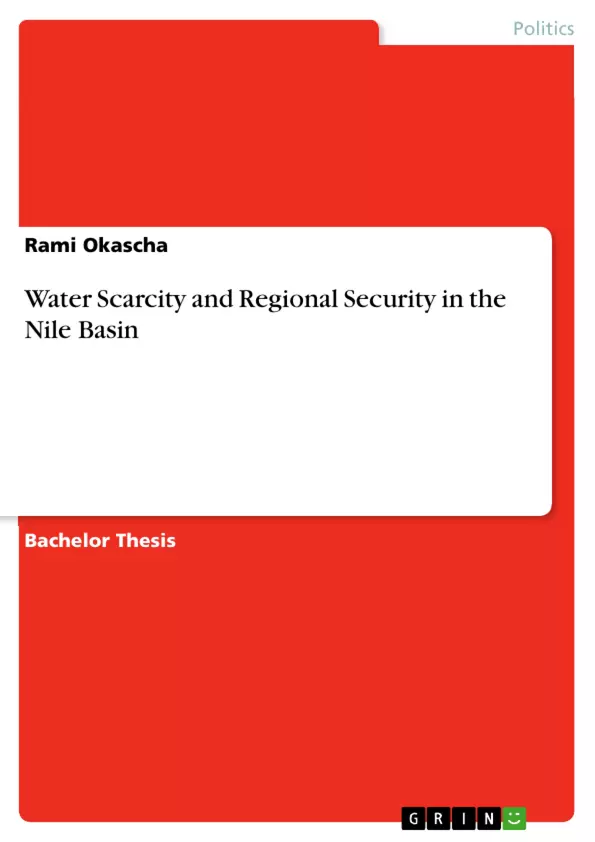Since South Sudan's secession in 2011 the Nile River is shared by eleven countries (Egypt, Sudan, South Sudan, Ethiopia, Eritrea, Tanzania, Uganda, Burundi, Rwanda, D.R. Congo, and Kenya) and is home to more than 160 million people. Five of these countries are among the poorest in the world, with low levels of socio-economic development or - in other words - with tremendously high potentials and motivation to socio-economically develop. Today, exploitation of the Nile has reached its limits with ever greater populations and industries depending on its waters. History has created political power structures which represent the exact opposite of the hydrological realites. Although the river receives no contributions from Egyptian territories, the country is the most excessive consumer of Nile waters and dependent on it for about 95% of its freshwater resources. At the same time, precipitation in the Ethiopian highlands delivers some 85% of the Nile's flow measured at Aswan. But the prevailing river regime in combination with a history of political instability has so far prevented Ethiopia and other upstream countries from constructing major schemes to facilitate economic development or even flood protection for its population.
Will increasing resource competition lead the states of the Nile Basin to full-scale inter-riparian conflict?
Egypt with its very limited availabilty of arable land and already over-exploited and contested water resources must consider to at least partially abandon its pursuit of food self-sufficiency and examine alternative ways of securing its population's needs.
Given growing pressures on the Nile's resources, the Basin states' current order will have to fundamentally shift from the current lower-basin domination to a more integrative regional system that appreciates both the upperriparians' contributions and development needs as well as the lower-riparians' dependence upon their cooperation. Considering the most recent trends in scientific literature on transboundary water resources, this transformation is expected to be accomplished through cooperative action rather than resisted against through inter-riparian conflict. This paper argues that Egypt will, despite the repeated threats uttered against underdeveloped upstream states' claims for more equal shares, lose its hitherto dominant position and engage in cooperative efforts exceeding current frameworks like that of the World Bank's NBI.
Inhaltsverzeichnis (Table of Contents)
- Water Use
- Introduction
- A Brief History of Nile Politics
- Current Basin Regime
- Hydrological & geographical circumstances.
- Development Projects.
- Ethiopia
- The Sudan
- Egypt. .
- Hydropolitical Implications
- Hydropolitics between Conflict and Cooperation
- The Concepts of Security and Conflict
- The Power Matrix Model .
- From "Water Wars" to "Water Peace"
- Hegemonial cooperation?
- Cooperation within the NBI
- Conclusion
Zielsetzung und Themenschwerpunkte (Objectives and Key Themes)
This paper aims to analyze the impact of water scarcity on regional security in the Nile Basin, considering the growing demands for the river's resources and the historical power dynamics within the region.- The historical context of Nile politics and the British legacy.
- The current water management regime in the Nile Basin and its challenges.
- The interplay between water scarcity, conflict, and cooperation in the region.
- The potential for regional cooperation and the role of initiatives like the Nile Basin Initiative (NBI).
- The future of water management in the Nile Basin and the potential for a shift towards a more integrative and cooperative approach.
Zusammenfassung der Kapitel (Chapter Summaries)
- **Introduction:** This chapter introduces the Nile Basin, its geopolitical significance, and the growing pressures on its water resources. It highlights the historical power imbalances and the need for a more equitable and sustainable water management system.
- **A Brief History of Nile Politics:** This chapter delves into the history of Nile politics, focusing on the British imperial legacy and its impact on water management practices in the region. It explores the role of water in shaping Egypt's economic development and the emergence of political power structures.
- **Current Basin Regime:** This chapter examines the current water management regime in the Nile Basin, including the hydrological and geographical conditions, development projects, and their hydropolitical implications. It provides an overview of the water allocation mechanisms and the challenges faced by different riparian states.
- **Hydropolitics between Conflict and Cooperation:** This chapter explores the concept of security in the context of water scarcity and conflict. It examines the potential for conflict arising from competition over water resources and analyzes the various frameworks for regional cooperation.
- **Cooperation within the NBI:** This chapter discusses the Nile Basin Initiative (NBI) and other initiatives aimed at promoting cooperation and sustainable water management in the region. It evaluates the effectiveness of these initiatives and explores the challenges of implementing them.
Schlüsselwörter (Keywords)
The primary themes and concepts explored in this paper include water scarcity, regional security, Nile Basin, hydropolitics, conflict, cooperation, historical context, British legacy, water management, development projects, Nile Basin Initiative (NBI), and cooperative frameworks.- Quote paper
- Rami Okascha (Author), 2012, Water Scarcity and Regional Security in the Nile Basin, Munich, GRIN Verlag, https://www.grin.com/document/233342



